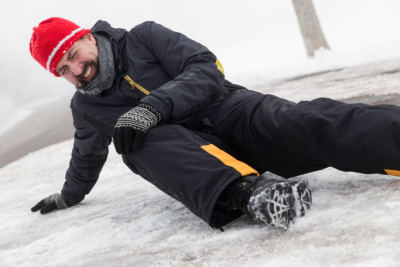While some might enjoy walking in a winter wonderland, if facilities managers aren’t careful, their employees’ journey could include slip, trip, and fall injuries, which can be costly for employers and employees. However, there are ways to be prepared for what Mother Nature has in store.

What Are Slips, Trips, and Falls?
The Occupational Safety and Health Administration (OSHA) defines slips, trips, and falls as:
- Slips: Loss of balance caused by too little friction between your feet and the surface you’re walking on. They occur in the winter because of pavement and sidewalk surfaces that are slippery from snow or ice.
- Trips: When your feet hit an object and you move with enough momentum to be thrown out of balance. Unsecured floor mats and snow-covered curbs can cause people to trip.
- Falls: When you move too far off your center of balance. This can happen due to slips and trips and result in injuries and fatalities.
Learn more by reading “Back to Basics: Slips, Trips, and Falls” on EHS Daily Advisor.
Injury Statistics
While slips, trips, and falls occur more often this time of year because of snow and ice, these types of incidents are expensive year-round.
The cost of “falls on the same level” for employers is $8.98 billion a year.
According to the U.S. Department of Labor, slip, trip, and fall accidents are:
- The cause of 15% (12,000 a year) of all accidental deaths;
- The second-leading cause of accidental deaths, behind motor vehicles;
- The most frequently reported of all injuries, causing 25% of insurance claims annually;
- Over 17% of all disabling occupational injuries; and
- 15% to 20% of all workers’ compensation costs.
In the latest data available, the U.S. Bureau of Labor Statistics shows there were 22 fatalities and 13,960 cases of injuries due to ice, sleet, and snow, with 5,870 injuries requiring a medical visit in 2020. But most of these injuries could have been prevented.
Complying with the Law
Employers should be concerned about winter slips, trips, and falls not just because of possible fatalities and injuries but also because being complacent could lead to civil and criminal penalties for breaking the law. They can avoid this by taking the following steps:
1. Promptly Remove Snow and Ice
According to the American National Standards Institute (ANSI) article on “Winter Slip and Fall Prevention,” after a winter storm, facilities teams should focus on “removal of winter obstructions on walkway drainage systems, stair systems, ramps, and handrails, as well as barricading hazardous areas to discourage pedestrian travel.”
Additionally, keep in mind that snow and ice need to be removed from internal roads, parking lots, sidewalks, and building entrances by using shovels, snow rakes, snow throwers, and snowblowers. Read about the pros and cons of each tool by checking out “Choosing the Right Tools for Snow Removal” on Facilities Management Advisor.
2. Use Chemicals
According to OSHA, employers are responsible for not only clearing walking surfaces of snow and ice but also spreading de-icer as soon as possible following winter storms.
For parking lots, use rock salt or, in unusually cold climates, calcium chloride; for road treatment, use liquid brine; and for building entrances, use non-chloride potassium. To learn more, read “Getting Your Facility Ready for Snow and Ice” on Facilities Management Advisor.
3. Use and Maintain Floor Mats
Floor mats inside facilities should be removed and replaced when saturated with moisture, according to the “Standard Guide For Commercial Entrance Matting In Reducing Slips, Trips And Falls” by ANSI and the National Floor Safety Institute (NFSI).
Consider installing floor mats that are at least 10 feet long, but use mats that are at least 20 feet long if you have a high-volume facility. Learn more about floor mats by checking out “Three Very Good Reasons for Installing Floor Mats” on Facilities Management Advisor.
4. Check Exterior Lighting and Drainage
Facilities managers should ensure their worksite complies with “OSHA 1915.82(a)(1)—Lighting,” which requires employers to ensure “each work area and walkway is adequately lighted.” Check to ensure walking paths, parking lots, and internal roads have adequate lighting, and replace any burned-out or damaged lights. Lighting allows employees to see snow and ice hazards more clearly.
Additionally, follow “OSHA 1910.22 (a)(1)—Walking-Working Surfaces,” which requires “walking-working surfaces” to be “in a clean, orderly and sanitary condition.” This applies to interior and exterior walkways. Also, ensure snow can drain into sewers or grass to prevent ice from constantly forming in the same locations.
Learn More
Avoid slips, trips, and falls by promptly removing snow and ice, using chemicals, installing floor mats, and checking lighting and drainage after winter storms. To learn more tips to stay safe, read “10 Safety Measures for Winter Workers” on Facilities Management Advisor.
